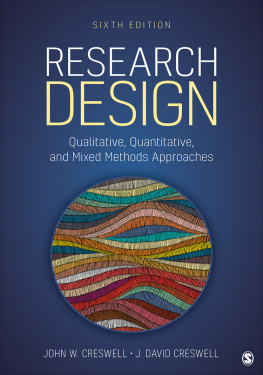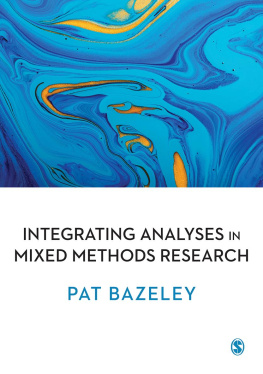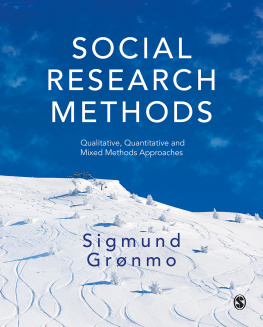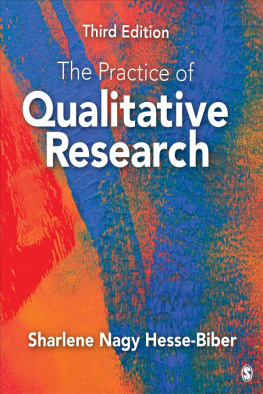No part of this book may be reproduced, translated, stored in a retrieval system, or transmitted, in any form or by any means, electronic, mechanical, photocopying, microfilming, recording, or otherwise, without written permission from the publisher.
Hesse-Biber, Sharlene Nagy.
Mixed methods research: merging theory with practice / Sharlene Nagy
Hesse-Biber.
p. cm.
Includes bibliographical references and index.
ISBN 978-1-60623-259-0 (pbk.: alk. paper) ISBN 978-1-60623-505-8 (hbk.: alk. paper)
1. Social sciencesResearchMethodology. I. Title.
H62.H477 2010
001.42dc22
To the incredibly gifted Boston, Massachusetts, medical doctors who continue to fight the battle against breast cancer each dayPatiksha Patel, Harold Burstein, Jay Harris, and Mehra Golshan. Thank you all so much for your expertise and support.
T his book offers a comprehensive perspective on mixed methods research that emphasizes the central place of the research problem in mixed methods design and practice. The state of the field of mixed methods research is currently methods-centric; it focuses primarily on the construction of mixed methods designs, often to the detriment of how they interact with the research problem.
Lacking as well is an appreciation of the diversity of different methodological standpoints that currently employ a mixed methods approach or seek to do so. A plethora of mixed methods studies assume the standpoint of a positivist interpretation fueled by a growing movement in the social sciences toward more evidence-based research practice. Qualitative approaches to mixed methods remain marginalized in mainstream books and articles on the topic. If this point of view appears in a discussion of this method, it often takes on the standpoint of second best. This book seeks to upend this relationship and perhaps turn it around in a variety of ways and to provide a reconceptualization of the mixed methods process through the lens of a qualitative approach.
Understanding the role and importance of mixed methods in social science research is a journey perhaps best taken together. This book makes use of the terms we and our in reference to the exploration that you, the reader, and I, the author, will conduct together throughout the course of this book. In doing so, we are consciously eliminating the traditional line that separates the authoritative voice of the author from the valuable input and experiences of the reader. In remaining open-minded about the relationship between author and reader, we hope to bridge the distance often imposed unnecessarily between them.
Continuing on the theme of dialogue within this book, we discuss how researchers taking a qualitative approach can successfully use mixed methods without having one component always taking on the primary role. We also discuss those specific research problems that particularly lend themselves to a mixed methods design, the process of generating a mixed methods question, and how to match a given research problem with a specific set of methods. I provide a set of refexive strategies for finding your research standpoint, and, in doing so, I hope this connection will serve to keep your research projects grounded and focused.
Along the way, we work through a set of suggested guidelines for generating a mixed methods research problem, dealing with specific ethical issues that may arise in conducting mixed methods research, as well as tips and procedures for gathering data, analyzing, interpreting, and writing up a mixed methods project.
We look at a set of in-depth case studies of mixed methods practice across a variety of qualitative approaches, starting with an overall discussion of the qualitative approach to mixed methods, as well as three specific approaches, with one chapter on interpretative research, another on qualitative feminist approaches, and the last on qualitative postmodern perspectives. I then take you through an extended example of the overall application of a qualitative mixed methods approach, breaking down the steps of putting together a mixed methods research design.
Along the way, I include researcher standpoint accounts from some leading scholars in the field of mixed methods research, asking them to personally and professionally refect on their own experiences with mixed methods theory and practice. The work of some of these scholars and researchers is included among the in-depth case studies presented in this book.
Although the book centers on qualitative approaches to mixed methods research, it also provides space for dialogue among various researcher standpoints. I hope this book will be the beginning of a series of dialogues across methodological divides. The qualitative quantitative methods divide is not the main issue confronting mixed methods research; rather, it is the absence of an awareness that all research comes from somewhere. In particular, this book is a call for researchers to grapple with and identify their particular standpoint on social reality and the construction of knowledge and to incorporate this awareness into their research practice at every stage, including, and most important, their choices about research methods and design. Some researchers may occupy multiple methodological standpoints, and these can shift and perhaps blend depending on, among other things, the particular research context, their methods training, and their acceptance of a diversity of theoretical perspectives. Researchers may find that they need to compromise or accommodate anothers point of view as a project proceeds. It is nonetheless important that we are clear on what set of research standpoints we engage with in a research project.
There is a growing movement toward interdisciplinary research, and in the coming decades, this form of research structure will require a team-based approach, most likely working with researchers who occupy multiple research standpoints. There are often pressures on this kind of multidisciplinary research team to communicate across their methodological divides. In order for interdisciplinary work to be truly interdisciplinary, we must develop an awareness that knowledge building comes from a point of view, even if this may challenge more entrenched forms of knowledge building within a team. It may, in fact, come to pass that in the process of reaching over methodological divides, a renewed appreciation of the viewpoint(s) of the other will emerge, even if methodologies remain separate and divided within a project. Not all research projects should or need to mix their methodologies, but sometimes this process is important depending on the research goals of the project. In this case, methodological engagement can lead to a richer set of new questions ripe for mixed methods or emergent methods practice.
Lets begin our journey together.
I would like to thank all those who have supported me along the way. First and foremost, I thank my family: my husband, neurologist and sleep specialist Michael Peter Biber, MD, whose love, sense of humor, and understanding is invaluable to me; and my daughters, Sarah Alexandra Biber, a Brandeis doctoral student majoring in genetics, and Julia Ariel Biber, City University of New York doctoral student majoring in cello performance, who support and cheer me on with my book projects but also remind me that there are other things in life besides writing a mixed methods book! I love you all!









